A Batu Caves Half Day Trip From Kuala Lumpur By Public Transport
This destination trip report will cover a visit to the Batu Caves outside of Kuala Lumpur, which can easily be done as a half-day trip with public transport.
Batu Caves
The Hindu temples of the Batu Caves is perhaps the most impressive sight in the greater Kuala Lumpur (KL) area – and it is remarkable easy to get there by public transport.
A lot of people visit the caves as part of an organised tour or decide to take a taxi (or using a rideshare app such as Grab which is king in KL) to get there. While these can be good options, it is just as easy to reach this remarkable sight by taking a local suburban train.
Commuter train service
There is a direct suburban commuter train service (KTM, also listed as ‘kmuter’ or ‘komuter’) which stops at several stations in the centre of Kuala Lumpur.
You can hop on a train to the Batu Caves from important interchange stations such as Kuala Lumpur Sentral (KL Sentral, the main station of the city) or Bank Negara among others.
Some of these stations are walking distance from some of the most popular KL areas where most tourists stay or otherwise a short taxi or metro or monorail ride away.
In my case, staying at the citizenM hotel in Bukit Bintang meant that the historic, colonial-era Kuala Lumpur station was a leisurely 20 minute walk away.
Old Kuala Lumpur station
British architect Arthur Benison Hubback, who designed several other famous colonial buildings worth visiting in Kuala Lumpur, is also the designer of Kuala Lumpur’s old colonial-era railway station.
Although nowadays it is not the city’s main train station (all Malaysian intercity train departures have been moved to the modern shopping mall-like KL Sentral further south), it is well worth it to actually begin your journey here if you can to admire the Moorish-style landmark.
In timetables, the old station is often simply called ‘Kuala Lumpur’ while KL Sentral refers to the modern-day central station.
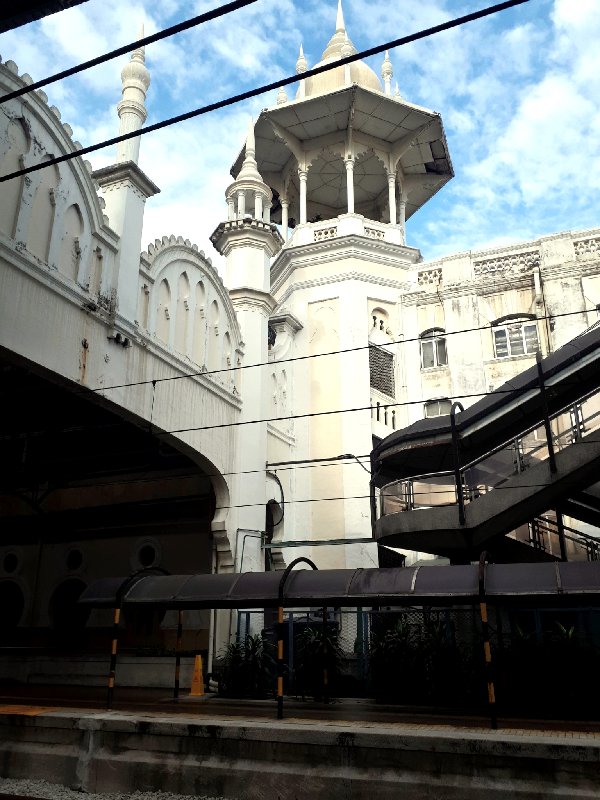

Tickets
Buying a ticket at the train station caused a mild headache as the sales office did not accept cards and had no change back to my bigger banknotes.
Even though a one-way ticket should cost a maximum of 4 RMB (0.83 EUR) I had to buy a slightly more expensive multiple-ride pass as there were no shops in the vicinity where I could break down my banknote into smaller notes.
It is highly recommended to arrive with some small change at the train station – especially if you start your journey at the old Kuala Lumpur station (it should be less of a problem at the more modern KL Sentral, which has the additional benefit of having dozens of shops nearby).
Inside the station
With the ticket in hand, you can open the barriers to the actual platforms of the train station. If you need to stock up on some refreshments (highly recommended in the hot and humid KL weather), there are some small kiosks selling drinks and snacks on the platforms.
At the old Kuala Lumpur station, you will need to head to the middle island platform (number 3) for departures to the Batu Caves.
Trains run at least once an hour, more at peak times. Seating in the train is unreserved so you can take any seat you want – although be careful not to sit in one of the women-only wagons if you are a man!

Arriving at the caves
It is a short and straightforward five minute walk from the Batu Caves commuter train station to the actual complex – which is free to visit. After passing some shops and restaurants you arrive at the first of many Hindu temples at the grounds.
The actual caves in the limestone rocks are millions of years old. Indiginious people even used it to collect guano – bat excrement – as a fertiliser for their fields.
However, the Hindu temples are actually fairly new. A local Indian trader decided at the end of the 19th Century that the location was perfect to construct several temples dedicated to Lord Murugan – the Hindu God of war.
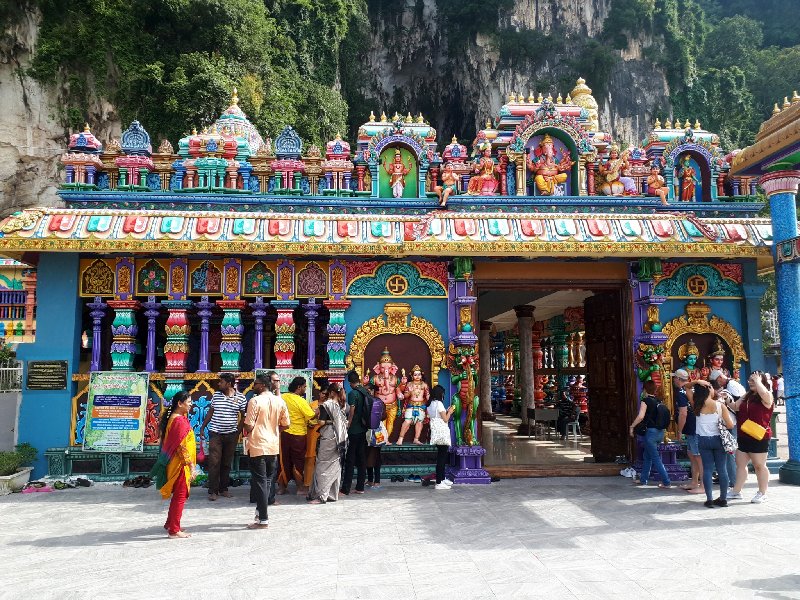


Temples
There are several temples to be found in and outside the Batu Caves, all of them equally colourful. The best known are located inside the actual cave high into the hill, being built under the high vaulted ceiling.
To reach it, you have to climb 272 concrete steps up which are watched over by a giant golden statue of Lord Murugan himself. These steps were painted in all colours of the rainbow in August 2018.
Although without doubt a pretty sight, local conservationists have criticised the move to paint the steps as they say it was done without proper authorisation and breached heritage protection laws.
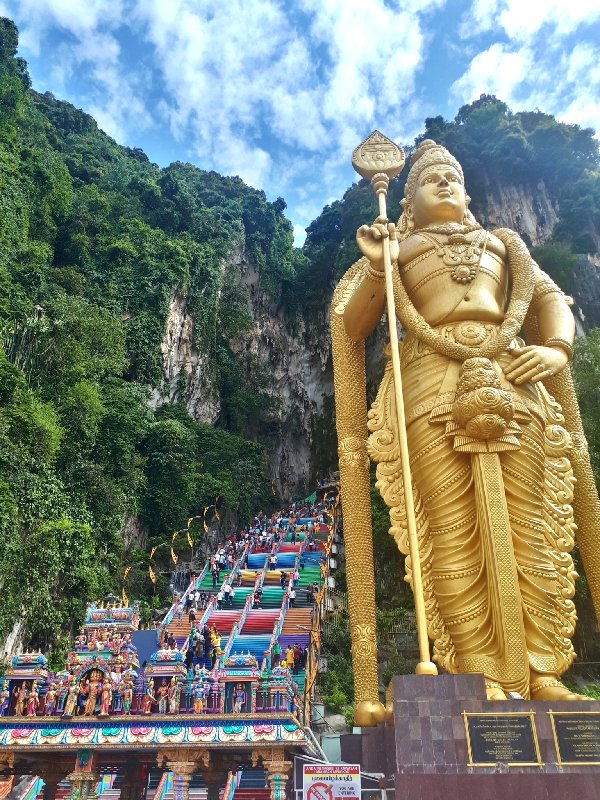
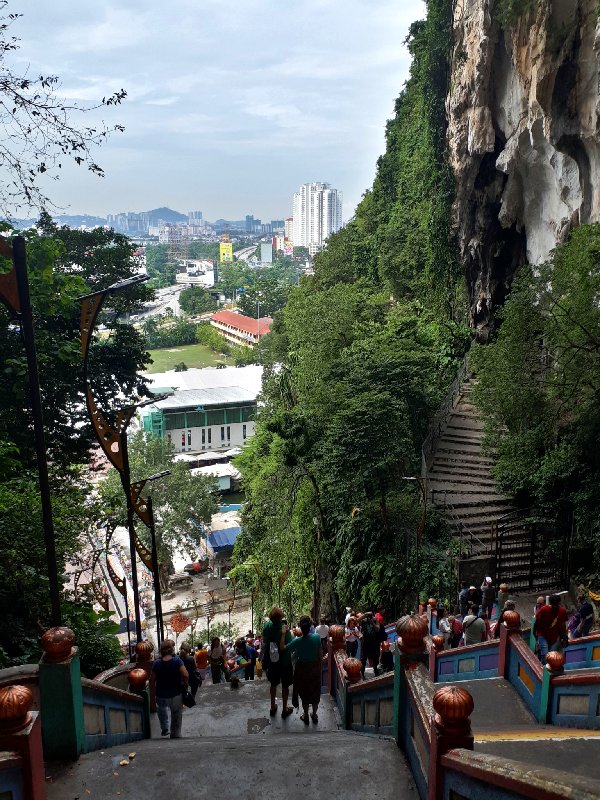

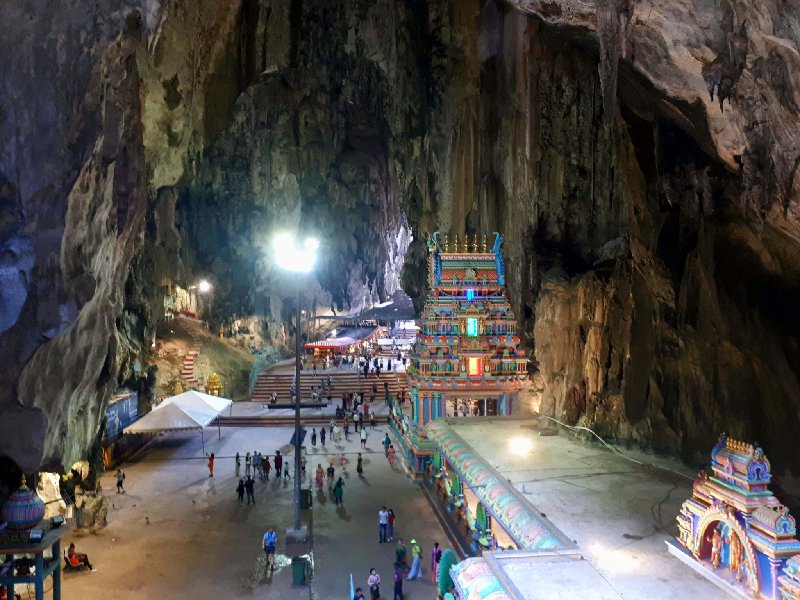
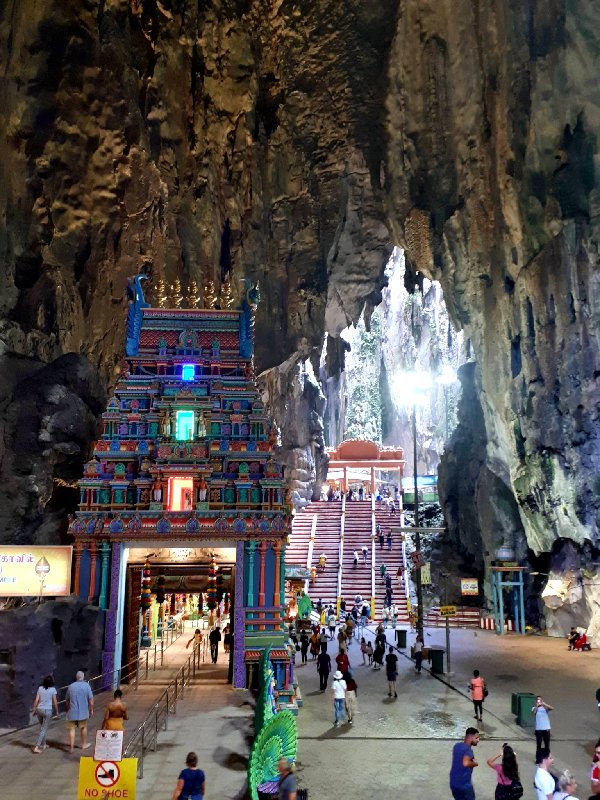
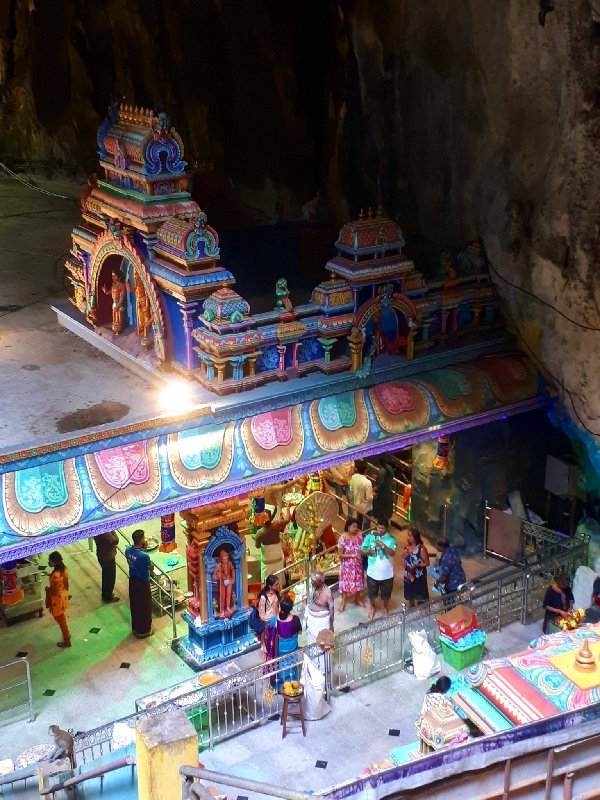
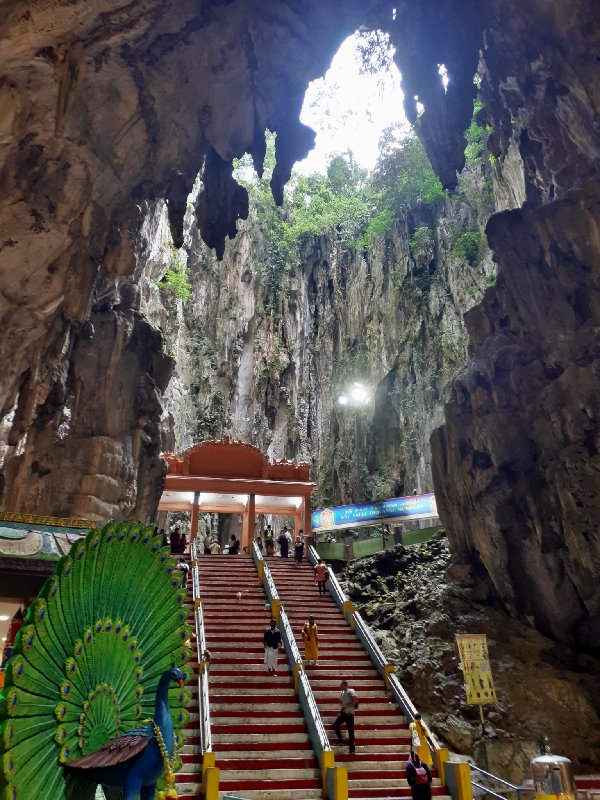

Monkeys
It is not only the cave and the Hindu temples which are the big tourist draws here. Equally worth admiring are the dozens of amazingly cute long-tailed macaques (Macaca fascicularis) walking around the site.
Tourists and locals alike feed oranges and other fruits to these monkeys. However, you are best advised to keep at least some distance from the macaques, as some are known to bite people or to grab personal belongings! Photographing them from three feet or so away is however perfectly fine and safe.

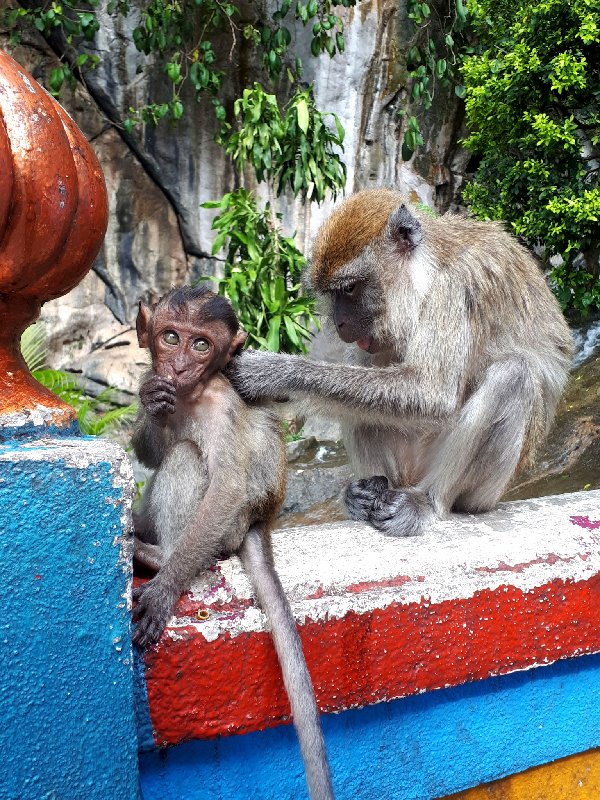

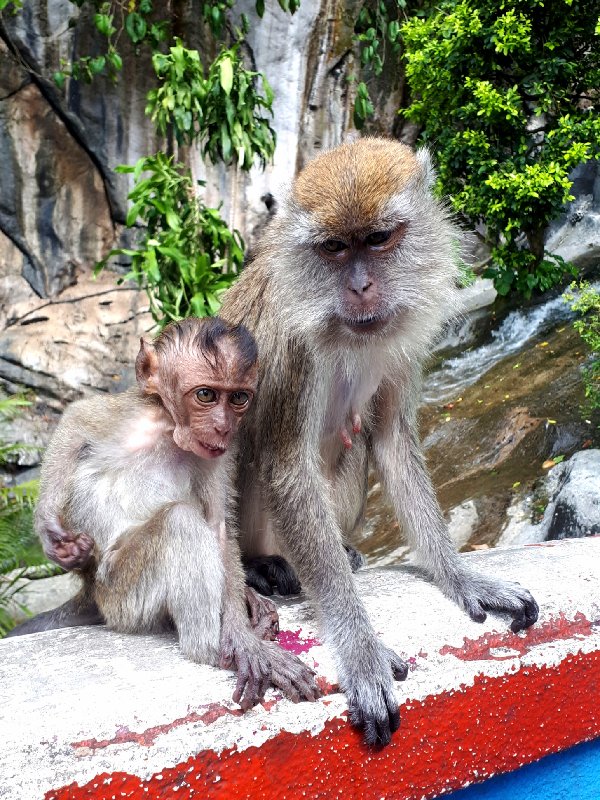
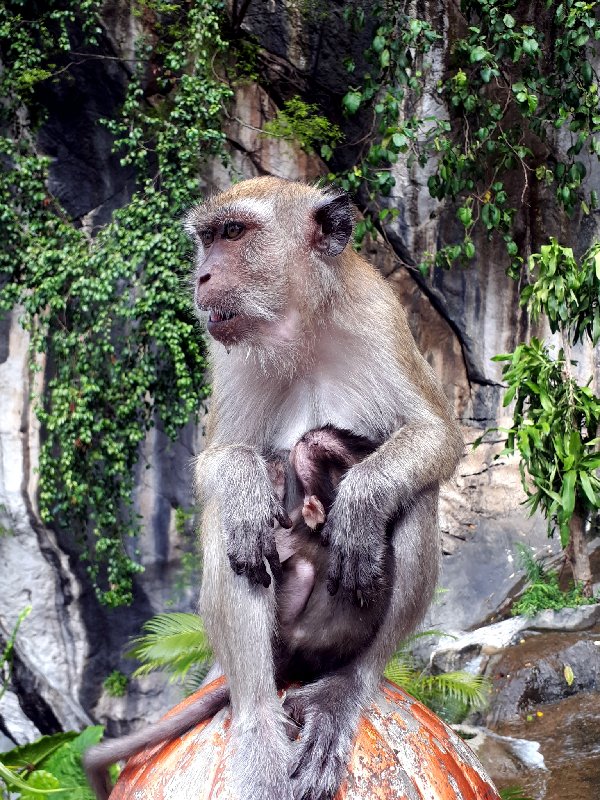
Cave villa
Next to the stairs up into the Batu Caves you will also find a large villa built against the cliff-side with a beautiful pool in front of it. This villa is home to some Hindu artwork as well as some terrariums and cages with reptiles and mammals – and you can enter it for a small entrance fee.
Given the paltry ratings and the reportedly poor condition in which the animals are kept inside, I did not bother to visit it. You can instead easily snap a picture of the picturesque villa and the grounds by walking from the fence outside.
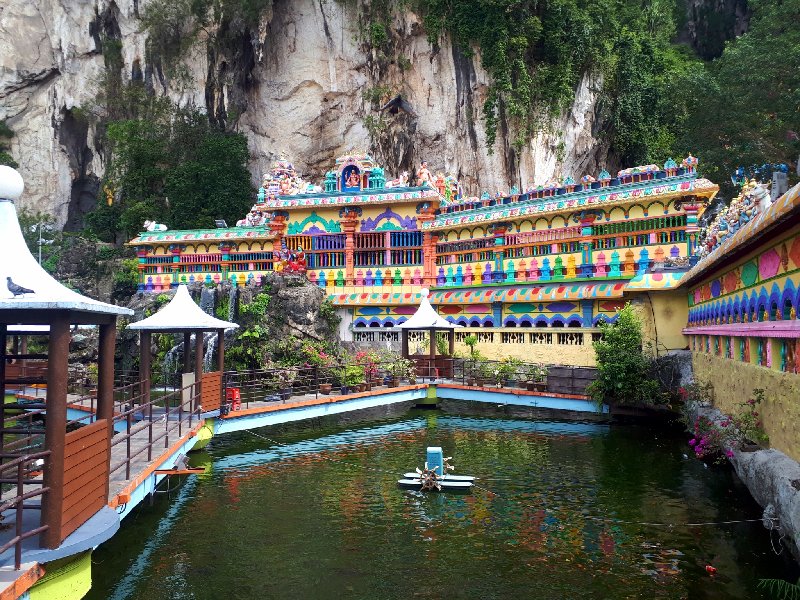
Back to KL
After a quick ice coffee at one of the cafes near the caves it was time to head back to Kuala Lumpur proper by commuter train.
I easily managed to see everything in and around the caves in about two-and-a-half hour, although it is easy to take half a day to explore all the grounds if you want to take it all in at a really leisurely pace.
Do note that it is quite a climb up to main cave and that the elderly or those with mobility problems might find it impossible to reach it. That said, there are plenty of smaller temples at ground level which are worth it to explore.
Overall, I’d say the Batu Caves are definitely an unmissable sight for anyone visiting Kuala Lumpur.
Trip report index
This article is part of the ‘Lazing in Laos and Gallivanting a Wee Bit Around Asia‘ trip report, which consists of the following chapters:
1. Review: Aegean Airlines Business Class Bucharest to Athens (Airbus A320)
2. Review: Goldair Handling Lounge (Non-Schengen) Athens Airport
3. Review: Saudia Business Class Athens to Jeddah (Airbus A320)
4. Review: Saudia Alfursan Lounge Jeddah Airport South Terminal
5. Review: Review: Saudia Business Class Jeddah to Kuala Lumpur (Boeing 787)
6. Review: CitizenM Hotel Kuala Lumpur Bukit Bintang
7. Kuala Lumpur in One Day: What to See and Do in 24 Hours
8. A Batu Caves Half Day Trip From Kuala Lumpur By Public Transport (current chapter)
9. Review: Plaza Premium Lounge Private Resting Suite Gateway KLIA2
10. Review: Air Asia Kuala Lumpur to Vientiane (Airbus A320)
11. Review: Hotel Khamvongsa, Vientiane, Laos
12. Destination Trip Report: A Day in Vientiane, Laos
13. Guide: Domestic Bus Travel in Laos and How to Book a Ticket
14. Review: Simon Riverside Hotel, Vang Vieng, Laos
15. Trip Report: Vang Vieng – Worth a Stop on Your Laos Itinerary?
16. Review: Villa Ban Phanluang, Luang Prabang, Laos
17. Luang Prabang: The Stunning Pearl of Indochina
18. Guide: Luang Prabang Morning, Food and Night Markets
19. Kuang Si Falls: A Gorgeous Luang Prabang Day Trip
20. Review: Thai Smile Economy Class Luang Prabang to Bangkok (Airbus A320)
21. Review: Ibis Styles Bangkok Sukhumvit 4
22. Review: Air France/KLM Business Lounge Bangkok Airport
23. Review: Garuda Indonesia Business Class Bangkok to Jakarta (Boeing 737-800)
24. Review: Sapphire Plaza Premium Lounge Terminal 3 Jakarta Airport
25. Review: Garuda Business Lounge Terminal 3 Jakarta Airport
26. Review: Review: Japan Airlines Business Class Jakarta to Tokyo Narita (Boeing 787-8)
27. Review: Capsule Hotel Transit Shinjuku, Tokyo, Japan
28. Tokyo Stopover: What to See and Do in the Capital of Japan for a Day
29. Review: ANA Business Lounge Tokyo Narita Airport
30. Review: United Club Tokyo Narita Airport
31. Review: Turkish Airlines Economy Class Tokyo Narita to Istanbul (Boeing 777)
32. Review: Turkish Airlines Miles&Smiles Lounge Istanbul Airport
33. Review: Turkish Airlines Economy Class Istanbul to Bucharest (Airbus A330)

